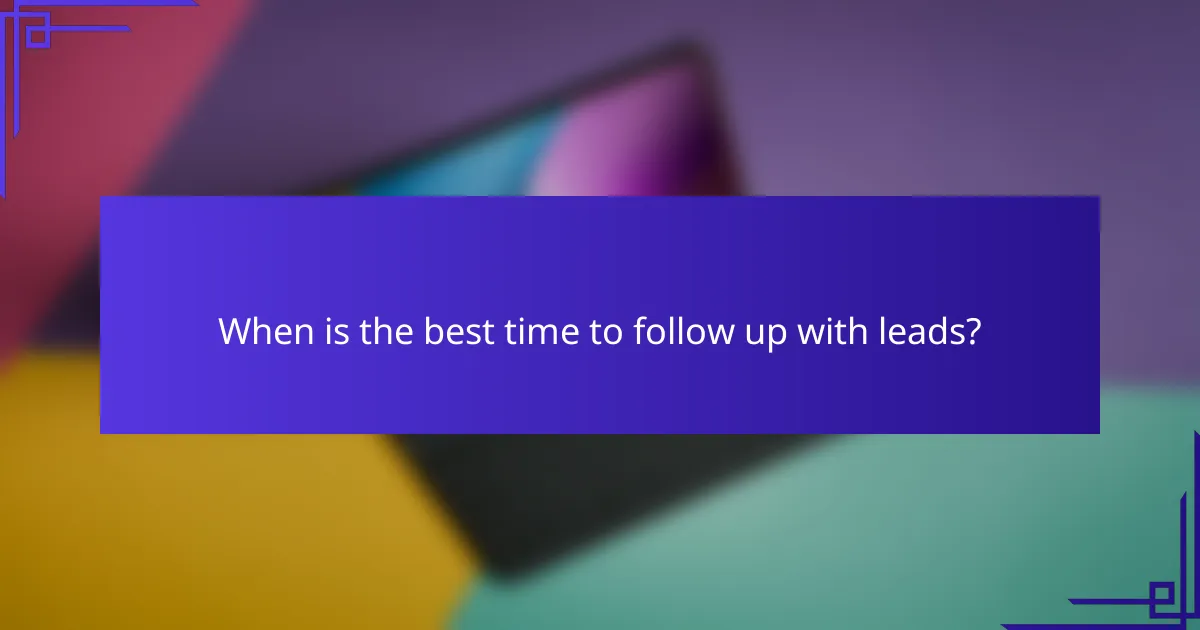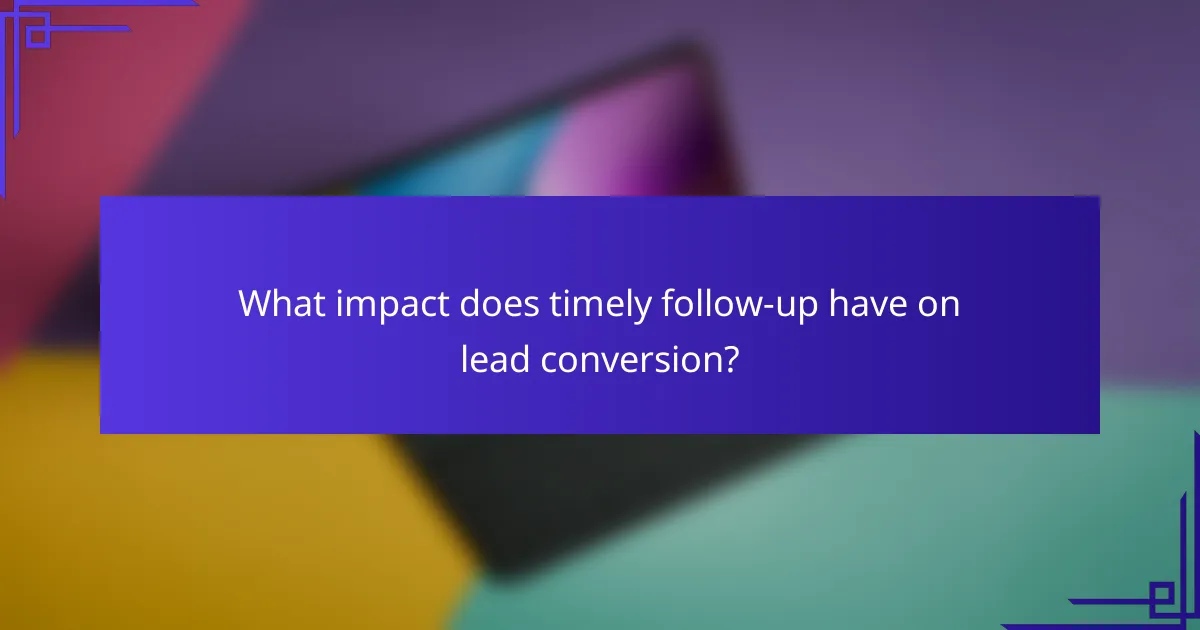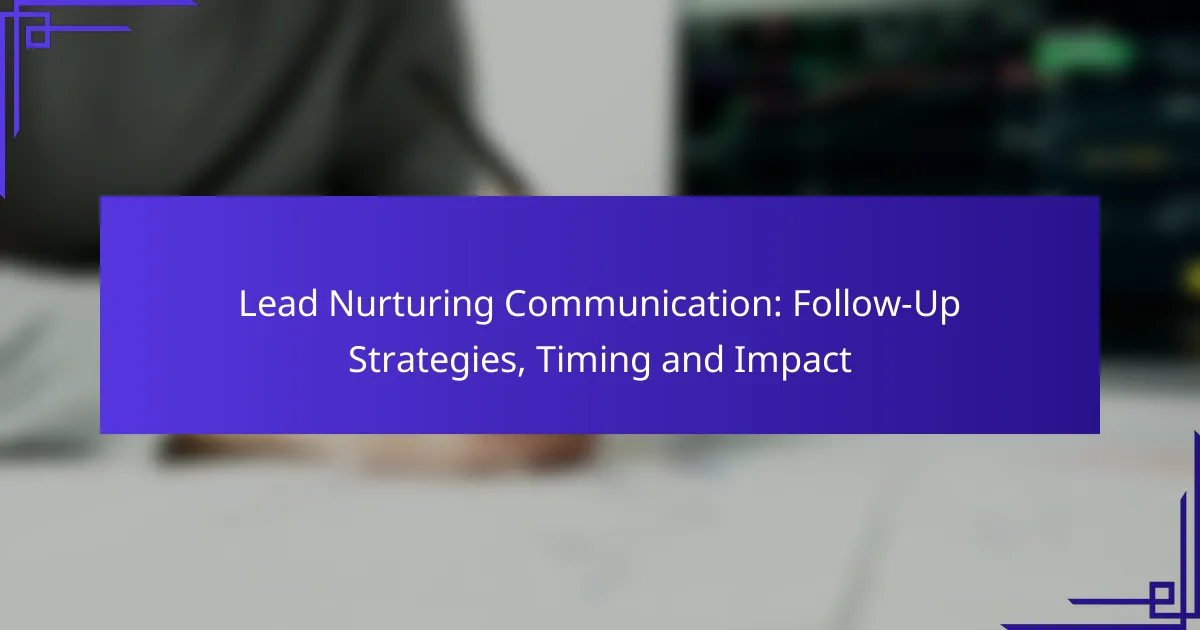Lead nurturing communication is essential for converting potential customers into loyal clients, and effective follow-up strategies play a pivotal role in this process. By employing timely and relevant communication methods, businesses can maintain engagement and guide leads through the sales funnel. Understanding the optimal timing for follow-ups can significantly enhance conversion rates, making it a critical aspect of successful sales strategies.

What are effective follow-up strategies for lead nurturing?
Effective follow-up strategies for lead nurturing include timely and relevant communication methods that keep potential customers engaged. These strategies help build relationships and guide leads through the sales funnel, increasing the likelihood of conversion.
Email follow-ups
Email follow-ups are a crucial component of lead nurturing, allowing for direct communication with potential customers. Sending personalized emails within a few days after initial contact can significantly enhance engagement. Aim for a series of emails that provide value, such as tips, resources, or answers to common questions.
Consider segmenting your email list based on lead interests or behaviors to tailor your messages. A/B testing different subject lines and content can also help identify what resonates best with your audience.
Personalized phone calls
Personalized phone calls can create a strong connection with leads, making them feel valued. Timing is essential; reaching out within a week of initial contact is often effective. Prepare a script that addresses the lead’s specific needs and interests to make the conversation more relevant.
Keep the call concise and focused, aiming to establish rapport rather than making a hard sell. Follow up with an email summarizing the call to reinforce the connection and provide additional information.
Automated messaging sequences
Automated messaging sequences can streamline your follow-up process while maintaining engagement. These sequences can include welcome messages, reminders, and educational content sent at strategic intervals. Set up triggers based on lead actions, such as website visits or email opens, to personalize the experience further.
Ensure that the messages are spaced appropriately, avoiding overwhelming leads with too much information at once. Regularly review and optimize your sequences based on engagement metrics to improve effectiveness.
Social media engagement
Engaging leads through social media is an effective way to nurture relationships. Regularly share valuable content and interact with leads by responding to comments or messages. This approach helps maintain visibility and fosters a sense of community.
Consider using targeted ads to reach specific segments of your audience on platforms like Facebook or LinkedIn. These ads can promote special offers or content that aligns with the interests of your leads.
Content sharing
Sharing relevant content is a powerful strategy for nurturing leads. Provide valuable resources such as blog posts, whitepapers, or case studies that address the challenges your leads face. This positions your brand as a trusted authority and keeps leads engaged.
Utilize various formats, including videos and infographics, to cater to different preferences. Regularly assess which types of content generate the most engagement and adjust your strategy accordingly.

When is the best time to follow up with leads?
The best time to follow up with leads is crucial for maintaining engagement and increasing conversion rates. Timing can vary based on the type of interaction, but strategic follow-ups can significantly impact the likelihood of closing a deal.
24 hours after initial contact
Following up within 24 hours of the initial contact is essential to keep the conversation fresh in the lead’s mind. This prompt response shows your eagerness and professionalism, reinforcing their interest in your product or service.
During this follow-up, recap the main points discussed and address any immediate questions the lead may have. A simple email or a quick phone call can suffice, ensuring you remain top-of-mind without overwhelming them.
One week after the first meeting
A follow-up one week after the first meeting allows you to gauge the lead’s thoughts and address any concerns that may have arisen. This timing is effective for reinforcing the value of your offering and demonstrating your commitment to their needs.
In this follow-up, consider sharing additional resources or insights that align with their interests. A personalized message can enhance the relationship and encourage further engagement.
Monthly check-ins
Monthly check-ins are vital for nurturing leads who may not be ready to make a decision immediately. These regular touchpoints help maintain the relationship and keep your brand in their consideration set.
During these check-ins, provide updates on new products, industry trends, or relevant content that may interest them. Aim for a balance between being informative and not overly sales-focused, allowing the lead to feel valued without pressure.

What impact does timely follow-up have on lead conversion?
Timely follow-up significantly boosts lead conversion by keeping potential customers engaged and informed. Quick responses can lead to higher interest levels, ultimately increasing the likelihood of closing sales.
Increases conversion rates
Timely follow-up can dramatically increase conversion rates, often by double digits. Responding to leads within minutes rather than hours or days can make a substantial difference, as prospects are more likely to engage when their interest is fresh.
For example, businesses that follow up within the first hour of a lead’s inquiry often see conversion rates that are significantly higher than those that wait longer. A good practice is to aim for a response time of under 30 minutes whenever possible.
Builds trust and rapport
Quick follow-up helps build trust and rapport with potential customers. When leads receive prompt responses, they feel valued and understood, which fosters a positive relationship from the outset.
Establishing this trust can lead to long-term customer loyalty. Consider personalizing your follow-up messages to address specific needs or questions the lead may have, which can further enhance the relationship.
Enhances brand perception
Timely follow-up enhances brand perception by demonstrating professionalism and commitment. Prospects are more likely to view your brand as reliable and customer-focused when they receive quick responses.
In competitive markets, a strong brand perception can be a deciding factor for leads. Ensure your follow-up communications are consistent in tone and quality, reflecting your brand values effectively.

How can businesses measure the effectiveness of their follow-up strategies?
Businesses can measure the effectiveness of their follow-up strategies by analyzing key performance indicators that reflect lead engagement and conversion. These metrics provide insights into how well follow-ups are nurturing leads and driving them toward a purchase decision.
Lead conversion metrics
Lead conversion metrics track the percentage of leads that become paying customers after follow-up interactions. Commonly, businesses look at conversion rates ranging from 1% to 10%, depending on the industry and quality of leads. Monitoring these rates helps identify which follow-up strategies are most effective.
To improve conversion metrics, consider segmenting leads based on their behavior and tailoring follow-up communications accordingly. For example, leads who engage with content may respond better to informative emails, while those who have shown interest in a product might prefer personalized offers.
Engagement rates
Engagement rates measure how actively leads interact with follow-up communications, such as emails or calls. High engagement rates, typically between 20% and 50%, indicate that your follow-up strategies resonate with your audience. Tracking opens, clicks, and responses can provide valuable insights.
To enhance engagement, utilize A/B testing on subject lines and content formats to determine what resonates best with your leads. Additionally, timing your follow-ups based on lead activity can significantly improve engagement rates.
Customer feedback surveys
Customer feedback surveys are essential for gauging the effectiveness of follow-up strategies directly from leads. Surveys can reveal insights into how leads perceive your communication, with questions focusing on clarity, relevance, and timing. Aim for a response rate of around 10% to 30% for meaningful data.
When designing surveys, keep questions concise and focused. Consider using a mix of multiple-choice and open-ended questions to gather both quantitative and qualitative feedback. This information can guide adjustments to your follow-up strategies, ensuring they meet the needs of your leads effectively.

What tools can assist in lead nurturing communication?
Several tools can enhance lead nurturing communication by automating and personalizing interactions. These platforms help track leads, manage communication, and analyze engagement, making it easier to convert prospects into customers.
HubSpot CRM
HubSpot CRM is a popular choice for lead nurturing due to its user-friendly interface and robust features. It allows businesses to segment leads based on behavior and engagement, enabling tailored communication strategies.
Key features include email tracking, automated follow-ups, and customizable workflows. For instance, you can set up automated emails to follow up with leads after a specific action, such as downloading a resource or attending a webinar.
Salesforce
Salesforce is a comprehensive CRM solution that offers extensive lead nurturing capabilities. Its advanced analytics and reporting features help businesses understand lead behavior and optimize their communication efforts.
Salesforce allows for detailed segmentation and personalized messaging, ensuring that leads receive relevant content. Additionally, its integration with various marketing tools enhances the overall lead nurturing process, making it easier to manage campaigns effectively.
Mailchimp
Mailchimp is primarily known for email marketing but also offers features that support lead nurturing. It enables users to create targeted email campaigns based on lead data and engagement metrics.
With Mailchimp, businesses can automate follow-up emails and segment their audience to deliver personalized content. For example, you can set up a series of emails that nurture leads over time, gradually guiding them through the sales funnel.
